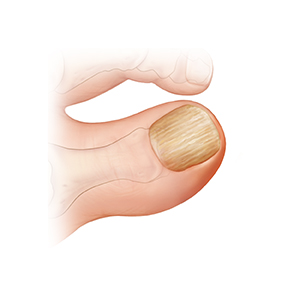Several things can cause very thickened nails. They can be caused by injuries or pressure from shoes. Fungal infections are a common cause. Diabetes, psoriasis, or vascular disease are other possible causes.
Symptoms of thickened nails
Along with thickening, the nail may have ridges, be brittle, or look yellowish. It may hurt when pressure is put on it. After a while, a thickened nail may get loose and fall off.
Assessment of thickened nails
Thickened nails may be a symptom of a medical condition. Because of this, your health care provider will look at your health history. The thickness and color of the nail are checked carefully. This helps to find the cause. A test may be done to check for fungal infection.
Treatment of thickened nails
-
For infection. Oral or topical antifungal medicines may be used to treat infection. These can help prevent sores under the nail. They also keep the fungus from spreading to other nails.
-
For thick nails not caused by infection. Thinning the nail may be an option. This can be done by trimming, filing, or grinding.
-
For pain. If the nail causes pain, part or all of the nail can be removed with surgery. Never try to remove a nail by yourself.
Preventing thickened nails
You can prevent many nail problems by wearing the right shoes and trimming your nails correctly. Keep your feet clean and dry to help prevent infection. If you have diabetes, talk with your health care provider before doing any foot self-care.
-
The right shoes. Get your feet measured. Your size may change as you age. This is due to ligaments that get loose with age and allow the bones in your foot to change position or spread. Wear shoes that are supportive and roomy enough for your toes to wiggle. Look for shoes made of natural materials, such as leather, which lets air get to the skin on your feet.
-
Correct trimming. To prevent problems, trim your toenails straight across. Then file the edges with a nail file. If you can’t trim your own nails, ask your provider to do it for you.


